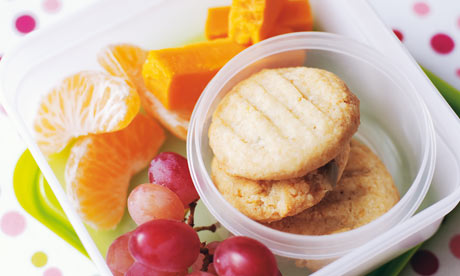
As modern parenting dilemmas go, it's up there with the dreaded "But why can't I watch telly for more than an hour?", "How come I have to go to bed at eight – nobody else does" and "What do you mean I can't have a Wii for my birthday?" debates: what do they eat when they come home from school? A few decades ago, the standard after-school snack was bread and butter, perhaps with jam or, if you were very lucky, an early chocolate spread. Plus a banana, maybe, and a glass of milk. On large parts of the continent, where the after-school snack is so important a part of the daily diet that it has its own name – le goûter in France, la merenda in Spain, la merienda in Italy – that's still pretty much the norm, although a whole range of goûter-specific cakes and biscuits are now available in case parents don't feel up to buttering a bit of bread.
In Spain, la merienda can be anything from a piece of bread with a bit of chocolate on top, to bread with chorizo, ham or salami. In Italy, it's generally a biscuit or two (officially recommended, combined with milk, as an important part of a balanced diet). In France, the much-loved chocolate Pepito and Prince biscuits were basically invented for the occasion, as was the brioche roll, the pain au chocolat, the crêpe, and even Proust's madeleine.
There's a popular blog in France that invites adults to recollect the great goûters of their childhood, and hundreds have obliged – the most popular being the simple chunk of crusty baguette, buttered, with a couple of squares of milk chocolate on top.
Of course, things aren't perfect there: the global junk-food giants are making inroads in France, and Spain and Italy, too. But they don't seem to have made quite so much progress as they have in Britain, where, according to a 2008 survey for the Federation of Bakers, crisps (51%), biscuits (44%), chocolates or sweets (40%) and fizzy drinks (24%) are the favoured after-school snacks of the nation's four-to -11-year-olds. Older children admit to similar habits, and although half of four-to-11-year-olds and a quarter of 11-to-16 year-olds fess up to the odd fruit, yoghurt or smoothie, one in four British parents apparently finds it difficult to persuade their children to snack on anything a nutritionist might consider remotely healthy. (Among the older group, who tend to buy snacks on the way home, 20% claim their parents haven't a clue what they're eating.)
In her book Bad Food Britain: How a nation ruined its appetite, Joanna Blythman reckoned British children consume 25 times more confectionery and 30 times more soft drinks than they did in 1950. And the Guardian's Felicity Lawrence, in Eat Your Heart Out, reported that by the age of seven, children are eating an average of half a kilo of sugary foods a day. The National Diet and Nutrition Survey found that 92% of British children consume more saturated fat than is recommended, 86% too much sugar, and 72% too much salt. Oh, and 96% don't get enough fruit and vegetables.
All of which helps explain this week's fuss over a Kellogg's poster featuring the company's cartoon character, Coco the monkey, dressed in school uniform and asking: "Ever thought of Coco Pops after school?" Twenty-six people and organisations, including the Children's Food Campaign, complained to the Advertising Standards Authority that the ad was irresponsible because it targeted schoolchildren, and encouraged them to eat a snack that was particularly high in sugar.
The ASA rejected the complaints, accepting the Kellogg's argument that although Coco Pops are approximately 35% sugar, there was no current UK or EU definition of "high" as far as sugar content is concerned, and in any case, compared to bananas, fruit yoghurt and toast and jam, Coco Pops actually contained less (the company bases that claim, it should be said, on a somewhat unrealistic 30g serving). Kellogg's also noted that Coco Pops were a source of iron, vitamin B and (when eaten with milk) calcium, had fewer calories, and were of greater nutritional benefit than the snacks they might replace.
The ruling disappointed Jackie Schneider of the Children's Food Campaign. It's difficult enough, she argues, persuading children to eat healthy, low-fat, low-sugar snacks, without them being confronted with poster campaigns promoting a cereal that is considered too unhealthy to be advertised on children's television or served in schools. "Obesity is a serious problem facing children," she says, "and we all need to play our part to encourage a healthier diet." Schneider wants to see legal protection for children from junk food marketing so that parents can be supported, free from undue commercial interference, in their effort to encourage children to eat – and snack – healthily.

